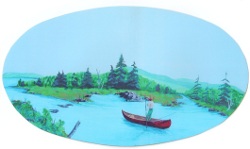Canoe Pole
Thank you for purchasing your canoe pole from Pole and Paddle Canoe. It has been sanded with 80 grit paper. When you get it home go over it again with 100 grit paper, removing any shipping dings and any small lines and flat spots that catch your attention. Just remember it was a square piece of wood, hand shaped to be round, and will never be perfect. DON'T drive yourself crazy. Fill a small coffee can or some other container of the same approximate size with a mixture of 50% turpentine and 50% BOILED linseed oil. Boiled linseed oil has driers added. Raw linseed oil does not and will not dry. Stand your pole against a wall with the shod tip immersed in the coffee can solution. The solution should cover the entire shoe plus about 1 foot. Leave your pole this way for about a day, topping off the mixture if it gets below the top of the shoe. The end of the pole is now sealed, and shouldn't need to be treated again. At the end of your season a swipe on the shoe with this same mixture will help prevent rust. REMEMBER any rags involved in this process are VERY prone to spontaneous combustion. DON'T risk it. Lay them outside, completely open and let them dry, then dispose of them properly. Now completely wet your pole. You can do this by using it or wetting it down with a sponge or hose. When it dries it will feel rough because you have raised the wood grain, or as we call them the hairs. Lightly sand the pole, removing the hairs. Repeat this process twice more. Your pole should now be as smooth as it's ever going to be. You can leave your pole untreated and let the oils from your hands be the only protection from the elements, pure but highly ineffective. A better method is to occasionally wipe the pole with the linseed oil mixture or teak oil. Some people like to varnish or shellac the octagonal portion of the pole and oil the rest. The oldtimers used to mix pine tar into the oil mixture for a little more protection and a darker color. No matter what oil mixture you use, several light coats allowed to dry completely between coats is better than one or two heavy coats that tend to turn into a gummy mess. You can now take that pole out and use it, knowing that you've done everything you can to make it last as long as possible.
Traditional Snowshoes
The world continues its trend towards no maintenance. With the introduction of aluminum frames and nylon fillings, modern snowshoes fit right in to this trend. Even though it's convenient, to us traditional outdoorsmen it's a shame. It does take a little time to take care of traditional gear, but you end up forming a relationship of sorts with each piece. You go over it inch by inch, note each ding and remember how it happened. Each piece means something to you and you do all you can to extend its life. When it's finally worn out, it may very well end up on display or in a favorite corner rather than in a landfill. It's hard to discard a piece of your life.
Basically there are two parts to a snowshoe, the frame and the filling. On truly traditional snowshoes the frame is wood, usually ash or birch, and the filling is rawhide (also known as babiche). Both need to be protected from water and wear. Both ash and birch have low resistance to rot. Rawhide absorbs water and stretches creating large sags in your webbing and because it's loose allowing the pattern to shift around creating larger and smaller holes. Wet, soggy rawhide also freezes, sometimes in undesirable shapes. While we are on the subject of wet filling, if you damage the filling in a snowshoe, fix it A.S.A.P. right now is even better. Use whatever you have for string or leather lace, nylon line will probably work the best as far as toughness goes. When you get time to do a permanent fix soak the snowshoe in water until the filling gets soft and stretches. Splice in a soaked piece of rawhide, maybe a salvaged piece of filling from a worn out snowshoe, following the old pattern as closely as possible, pull every back into place and pull everything tight. When the rawhide dries it will shrink and your webbing will be tight again.
So what is the best protection for your snowshoes, both frame and filling? I used to have the answer for that, but I'm not sure I do any more. I'll tell you what I know and you can choose for yourself. First a lot of the new snowshoes I've seen are not adequately protected, so I would sand both the frames and filling, not enough to do damage but enough to allow a new finish to penetrate and stick. I was taught to coat my snowshoes with the best spar varnish I could get. In this case I would put on three coats, it has always worked for me. When I was living in Upper Michigan I had the pleasure of working with a woodsman of French Indian descent. Believe me I donÂ’t call just anyone a woodsman. When he talked I listened. One day we got on the subject of snowshoes. His mother and father made their own and had taught him. When I mentioned spar varnish, he said they never used it. They used to lay their snowshoes in a shallow pan of some sort and immersed them in linseed oil, letting them soak up as much as they could. The oil would seal the rawhide and water couldn't penetrate it. I've never tried it but I have obtained a pair of snowshoes with almost all the varnish worn off. When I locate the proper sized pan I'm going to give it a try. Maybe you'll read about it on the Jack Mountain Forum, a link can be found on my web site poleandpaddle.com.
One of the best pieces of advice my woodsman friend ever gave me was, when shooting at game, be it with bow or gun , don't aim at the animal, aim at a single hair on the animal. That was his way of saying, concentrate on and aim at the smallest target possible.
AXE
The axe is one of the most important pieces of traditional gear and yet one of the most neglected. One of the biggest problems is a loose handle, second is a warn handle from splitting wood, and third is rust. Here is how I care for my own axes.
Loose handles come from moisture moving in and out of the cells of the handle wood. More moisture, tighter handle, less moisture, looser handle. I try to hange my handles when the humidity is about normal. In other words, I don't hange an axe in the middle of a rainy spell if I can help it. When I hange one in the winter I take in inside the house for a week or so and then retighten the wedge. Once you've tightened the wedge the axe should never be stored in the house again. This is really important if you have wood heat. The next step is to help protect the axe handle from wear while splitting wood. I have tried wrapping the handle with leather and twine from the head back 4" on the handle. A lot of people do this but I found it very unsatisfactory. It doesn't feel right when swinging the axe and the extra thickness actually causes the handle to bind in the split making each swing less effective. I have settled on boat epoxy such as West Systems. Tape your axe head completely and tape a ring about 4" back on the handle. Apply the epoxy withs a throw away paint brush. You want the coat thick enough to cover but not thick enough to run all over the place. The epoxy is strong enough to help protect the handle and thin enough and slippery enough to not bind in the split. The last step I take is to wax my handle and axe head. I have a butcher block wax that is part mineral oil and part beeswax. I get the handle as warm as I can and coat it and the axe head. Let it soak in and do it again. Wipe off any excess and recoat lightly when you think it needs it. The wax helps keep the moisture from moving in and out of the handle and prevents the head fom rusting. I have also been known to treat the wedge end of the handle with penetrating epoxy to block moisture penetration.
One last tip. Never put the axe head in a bucket of water to tighten it. It works but only until it dries, then it will be looser than ever. The water swells the wood but also softens the wood. The wood swells inside the unmovable eye of the axe head and the softened cells get crushed never to plump out again. If you don't want to rehange the axe try soaking the head in 50/50 boiled linseed oil/turpentine or teak oil.

